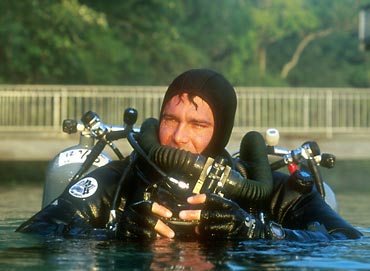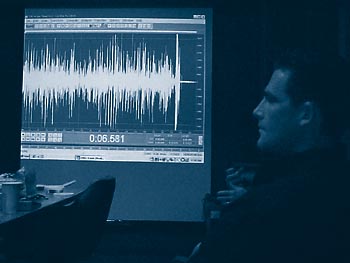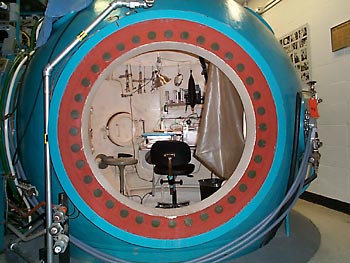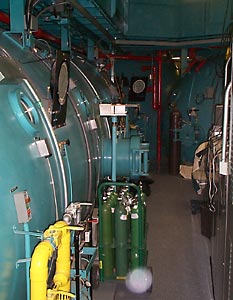Decompression Experimentation
Decompression ExperimentationBY JARROD JABLONSKI
From the logistics of underwater exploration to the strange malady that became known as decompression illness, divers and scientists have been struggling for decades to successfully investigate the underwater world. As early as 1670 Boyle described, with detailed accuracy, bubbles in the blood and body fluids of small animals subjected to low pressures. These bubbles, first located in the eye of a snake, marked more than 300 years of debate about the meaning, repercussions, and logistics of exposure to elevated ambient pressure. The quest for procedures that allowed effective immersion and safe retreat from hyperbaric exposures is dotted with a medley of evolving theories, best-guess practices, and hopeful global conceptualizations. Despite decades of research, many aspects of decompression are very poorly understood. For example, even the principle com-ponent(s) of hyperbaric illness remain(s) contested. Consider that, originally, painful symptoms were seen as the indication of bubbles impinging on nerves in the body, representations of an unsuccessful decompression. Yet, later studies indicated that gas bubbles (thought to be the precursor and eventual cause of painful DCS) were often present in the body when painful symptoms were not evident. These asymptotic bubbles were predicted as early as 1951 by Bateman and Behnke and termed "silent" due to their lack of symptomatic pain. The advent of ultrasonic monitoring techniques showed that these "silent" bubbles could be detected, often without any DCS symptoms being present. There did seem to be a very loose correlation between the size and frequency of Doppler detected bubbles and the onset of DCS. Yet, should the existence of these bubbles (separate from pain or other symptoms) be considered a form of DCS and, if so, what role should they play in modifying decompression profiles? Some individuals complain of DCS symptoms without detectable bubbles while some people with no pain have a very high presence of bubbles in their blood. Furthermore, some research indicates that microbubbles might permanently exist in the body, acting as seeds that may be fed by surrounding tissues or blood. Still other studies postulate the occurrence of bubbles that are formed in the arterial side, perhaps in the turbulent blood flow around the nodes of the heart. These and other widely divergent attempts to understand the nature of DCS demonstrate that we are far from any precise scientific model, one that can accurately describe the phenomenon and its associated symptoms. For individuals engaging in dives that require very limited decompression, these issues are arguably less problematic. These divers are, to some extent, insulated by the high number of diving profiles that establish a low statistical risk in a particular time/depth range. It is debatable to what extent this verifies any scientific model; instead, it may be principally an indicator of profiles with a risk well established through trial and error. Divers that extend beyond the recreational range into more aggressive diving profiles are more at risk; these divers have far fewer dives by which to gauge low statistical risk. While greater numbers of successful dives can reduce the statistical risk of certain profiles, several factors call into question the best dive profile. These issues include: the way one classifies decompression sickness (i.e., pain or bubbles), hyperbaric damage not immediately obvious to the diver (e.g., bone necrosis), the safest profile for aggressive or necessarily abbreviated decompression times, and the cascade of problems and/or inefficiencies associated with bubbles created at various places during the decompression profile (i.e., reduced efficiency and/or damage). The above complications are a sample of the problems confronting divers in general and technical divers in particular. Technical divers, due to their expanded depth and bottom times, have to be savvier about the particulars of safe decompression; this is particularly true for divers that engage in very aggressive dives. Aggressive diving profiles (i.e., long and/or deep) immerse the diver for long periods. Therefore, maximum decompression efficiency is essential, particularly in times where long immersions can expose the diver to additional risk, such as from bad ocean conditions or oxygen toxicity. Furthermore, it seems likely that bubble formation has an impact on the symptoms of decompression illness and that especially large collections of bubbles can be very dangerous. It is therefore prudent to enact procedures that are likely to limit the formation of bubbles. Procedures such as slowed ascent rates, limiting multi-ascent dives, and the use of safety stops are prudent well beyond the scope of theoretical decompression discussions. It will quickly become obvious to most seasoned technical divers that there is a great deal of variability in decompression profiles. For example, divers may follow vastly different profiles on the same dive, often with the very liberal diver experiencing the same success as divers with much greater conservatism. Conversely, some divers seem to experience problems with deep dives and/or long bottom times almost regardless of their decompression profile. Poor fitness, high fat content, and dehydration often appear when evaluating these decompression episodes, yet when trying to explain the variations in unsuccessful decompression, these factors paint an incomplete picture. To be sure, increased fitness, reduced fat content, and improved hydration have helped dozens of problem divers. However, decompression success remains a mystery to many divers and those undertaking very aggressive diving profiles have very little solid research information to rely upon.
It has often been said that necessity is the mother of invention. This motivation clearly ignited my passion for resolving decompression mysteries. The early years of technical diving found the mysteries of decompression consistently represented, but it was early involvement in the diving of the WKPP that heavily challenged inconsistencies in decompression knowledge and practice. As one of the early members of the WKPP, this challenge was amplified with diving that rapidly pushed the established decompression envelope. These early challenges are usually unknown or de-emphasized by most in technical diving, leaving many divers to imagine that technical diving has been popular for many years. In fact, very little deep and mixed gas diving occurred outside commercial/military operations. Furthermore, the diving done within these groups generally consisted of large support operations and often involved saturation diving. During the late 1980s, technical diving started to become more common among a very small group of divers. Not until the mid 1990s did the practice of deep and mixed gas diving become solidly entrenched within "recreational" (i.e., non-paid) circles and become acknowledged as technical diving. The lack of popularity experienced by technical diving during its early growth period led to a great deal of confusion and misinformation. Both diving leaders and individuals could be found promoting incorrect and dangerous misconceptions about the risks of Helium and the safety of deep air. Furthermore, there was a general confusion over proper decompression schedules and little solid information to guide one's efforts. For most early technical divers, obtaining deep, mixed gas decompression tables constituted one of many roadblocks to safe deep diving. Available tables tended to come from a hodgepodge of locations, and often relied on extreme conservatism as insulation against lack of under-standing. It was during these initial years that George Irvine and I began the ongoing task of actively refining practical decompression practices. As time progresses we continue to strive for "scientific validation"; yet, our earliest efforts and, to a lesser extent, our current focus centers on maximizing decompression efficiency and repeatability.We initially found that common decompression assumptions subjected divers to extremely long decompression obligations, ones that, regardless of their length, seemed inefficient. In other words, divers noted that very long decompressions seemed inefficient, and that by including a greater proportion of deeper stops than were commonly accepted they were able to reduce the length of shallower stops, thereby reducing overall decompression time. The result of this was that decompression became more effective, effectiveness being represented by subjective physical health. The earliest technical diving uses of deep stops were based almost solely upon personal experience. Several individuals, many within our group, toyed excessively with various ranges of deep stops, employing progressively deeper stops for varying times and then shortening the times in the pursuit of maximum efficiency. George Irvine and I pushed these and other assumptions to their limits, consistently striving to develop a means of maximizing decompression efficiency; George has been especially aggressive in this regard, helping to establish a true minimum range for decompression times. Divers from the WKPP established several working rules of thumb for deep stops, such as the convention of a first stop that should start one atmosphere shallower than one's maximum depth during the dive. I later worked with Erik Baker to study these techniques as part of a more global approach. Together with Simon Traemer and indispensable assistance from Gas Diving UK (Graeme Davison, Sue Davison, and Andy Kerslake) the group developed the first of several versions of DecoPlanner dive calculator. Here, deep stops are specifically defined by the point in which ambient pressure and leading compartment pressure (theoretical pressure within body tissues) are equal. Deeper than this point would actually result in on-gassing, while too shallow could promote bubble formation.
Ironically, the use of deep stops has a measure of scientific support, dating back to the 1950s, and is largely unknown to most technical divers. Physicist David Yount originally postulated that deep stops could reduce bubble formation. His studies initially focused on the first stop, evaluating the point at which bubbles would first form. The initial trials reported good success but divers were so entrenched in the conventional profiles that they resisted the idea of spending so much time at increased depth. These later studies, taken together with Yount's early work, became the basis for several theories, including VPM and RGBM. Assuming that there is good reason to believe that deep stops are done reasonably efficiently, one must then reflect on the next and perhaps more problematic phase of the decompression--that of middle or intermediate stops. Realistically, the concerns that guide the middle portion of decompression are similar to those that limit decompression in general. For example, there exists a fair degree of debate over exactly what causes DCS symptoms. Most people would agree that bubbles are a negative part in a chain of events that results in DCS symptoms. Consequently, we strive to reduce and/or eliminate bubble formation. Several theories strive to manage bubbling, and it may be theoretically possible to have a "no bubble" dive. However, the profiles often result in exceedingly long decompressions. Therefore, as divers we often accept the risk (or perhaps reality) that some bubbling is likely a consequence of diving. Assuming this is true one might conclude that a choice could be made as to where in the decompression profile bubbling creates the most trouble. Consider that bubbles formed at depth could grow and become dangerously large, impeding circulation more directly and/or for a longer time. The longer divers wait to accept a greater bubbling risk, the longer the decompression profile could become (due to necessarily longer stops and their resulting decompression obligations).To this end George and I worked to reduce the time in this mid-range of decompression stops, remaining convinced (particularly on long dives) that intermediate stops in conventional decompressions caused a large accumulation of gas that would then have to be eliminated. While this process has been successful, one should be aware that these times result in very high theoretical compartment pressures with M-values well above anything conceived under conventional "wisdom." Shortening the middle section of one's decompression might theoretically allow shorter shallow decompression stops. Personal experience indicates the truth of this assumption. However, divers should be cautious in their own personal experimentation.
During the early years of "recreational" deep diving (late eighties and early nineties), the use of Helium was often discouraged and an immense amount of fear was associated with its use. This fear stemmed largely from ignorance and a few early problems well known to the early deep divers (i.e., Hans Keller's fateful success and Hal Watts' DCS-laden Mystery Sink dive). Most early cave and wreck diving during this time was filled with discouragement for the use of Helium; many divers were told that the use of Helium led to much greater risk of central nervous system damage and that there was no safe way to decompress from Helium dives. For many years it was widely believed that if Helium must be used, divers should switch from it as soon as possible. Of course we later realized that these switches were unnecessary and dangerous, and that the emergency "need" for breathing air was irrelevant. Actually, there is no need for air anywhere in the diving profile. Instead, we realized years ago that safety and decompression efficiency were improved by using Helium in conventional air regions (i.e., 190-120 feet). Overcoming the misconceptions of deep air freed us to look at Helium in a variety of areas. George Irvine and I started using progressively higher Helium mixtures in different regions and began using Helium in areas shallower than 100 feet. The much longer decompressions we endured while pushing the far reaches of Wakulla led us to see Nitrogen as the real enemy. Analyzing our profiles led to the conviction that removing Nitrogen from the slow compartments was the true difficulty. Nitrogen was particularly troublesome with extensive intermediate and shallow decompression stops. I later began playing with Helium enriched gasses in the 120-150 foot range during decompression to assist in eliminating Nitrogen from the breathing mixes and reducing accumulation in the tissues. Helium use in the 120-150 foot range actually provides shorter calculated decompressions when doing very long dives such as those conducted in Wakulla, even when calculations are based upon conservative dissolved gas models. However, shorter dives (i.e., in the 20-30 minute range) are more problematic. For example, calculated decompression for 30 minutes at 300 feet with no Helium results in about 10 minutes less decompression than with Helium in both nitrox mixes, and about 5 minutes less than with Helium in the 120 bottle when calculated with standard Buhlmann algorithms. However, this additional time is not in keeping with personal experience and evolving decompression concepts (such as those demonstrated by bubble theory represented in VPM and RGBM). It seems, for example, that our own trials actually demonstrate that the body can tolerate greater quantities of Helium than Nitrogen. It may be that Helium is traditionally treated too conservatively, and that it is either able to off gas more rapidly and/or is tolerated at higher pressure. Alternatively, this may be individual physiology or misconception; yet time and continued trials seem to hint that Helium is useful in a wide variety of diving depths. GUE's VPM version of DecoPlan promises to allow further careful study of the interesting relationship between conventional dissolved gas conceptualizations and bubble-based algorithms. EXPERIMENTATIONThe previous discussion has been a brief, personal account representing more than a decade of individual and group experience. It is only fair to conclude this discussion with a note about the nature of decompression experimentation. The long-term effects resulting from hyperbaric exposure are difficult to quantify; even more problematic are the developments of sound decompression practices. Decompression diving (particularly aggressive technical diving) is very much an experiment in progress. Generally speaking, tables are, in my opinion, more a growing statistical reality justified by some (hopefully) relevant theory. In other words, modelers come up with new theories to describe what is going on. For Haldane it was the basics like different compartments, gas loading and removal, and the role of gradients in gas elimination/absorption. Haldane's efforts drastically reduced DCS risk, allowing divers to forge deeper for longer periods of time. More aggressive diving was permissible because divers were suffering far fewer cases of DCS. Eventually these new schedules did not satisfactorily protect the progressively more aggressive diving; DCS risk again became more prominent and new theories were developed. Each of these "new models" redefined the parameters based on theoretical assumptions. Each "success" with a new theory leaves us feeling justified in our result; in truth, numbers may be sufficiently tweaked to provide a better statistical fit with minimal representation of "reality." The point here is to demonstrate that all tables are largely a best statistical guess; our assumptions may be entirely incorrect. This analysis leaves one wondering what constitutes success. Should profiles be based upon limiting overt DCS symptoms (such as pain), reducing bubble presence (as measured by Doppler), or some combination? It is very likely that we do not fully appreciate the long-term repercussions of our diving or of our decompression experimentation. Yet, reasonable measures of success include limited painful DCS symptoms, successful Doppler tests, and favorable long bone x-rays, indicating that overt damage is at least limited while drastically reducing decompression time. Of course, only time will tell where these representations fall in the long string of decompression theories. I am willing to bet that they will prove to be a valuable and substantial push toward a more appropriate global conceptualization. Copyright ©2004 Global
Underwater Explorers.
All rights reserved. |





